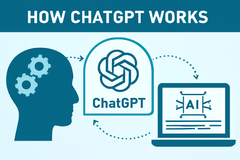
What is ChatGPT?
Discover the main takeaways from this article using AI
ChatGPT is a powerful tool that helps people with many different tasks. It uses artificial intelligence (AI) to understand and create text based on what users ask. You can talk to ChatGPT just like you would talk to a person, and it can help with writing, answering questions, or even creating new ideas. In this article, we will explain how ChatGPT works, some of the things it can do, and its limitations. Whether you're a student, a business owner, or just curious, this guide will give you a better understanding of how ChatGPT can help you.
How ChatGPT Works
ChatGPT works by analyzing patterns in the large dataset it’s trained on. When you provide a prompt, the AI predicts the most likely continuation based on those patterns. This allows it to generate responses that are coherent and contextually relevant, even in complex situations.
The model’s ability to generate text comes from transformer architecture, which enables it to process and understand vast amounts of data quickly. By recognizing connections between words, concepts, and ideas, it can produce responses that align with what the user is asking for.
Key Applications of ChatGPT
ChatGPT’s flexibility makes it a valuable tool across many industries. Here are some of its common uses:
-
Customer Service
Businesses often use AI-powered chatbots like ChatGPT to handle customer service tasks. These bots can answer questions, provide information, and resolve issues, helping improve both efficiency and customer satisfaction.
-
Education
ChatGPT is widely used in education. Students rely on it to clarify concepts, assist with homework, and even generate practice problems. It can also function as a study aid, providing explanations across a range of subjects, from math to literature.
-
Content Creation
Content creators—whether writers, marketers, or bloggers—use ChatGPT to brainstorm ideas, draft articles, and refine their content. It's particularly useful for generating blog posts, social media captions, or marketing copy.
-
Programming and Coding
For developers, ChatGPT can be a handy assistant. It can help write code, debug errors, or explain complex programming concepts, offering support for both beginners and experienced coders.
-
Creative Fields
In the creative industries, ChatGPT is used for generating poetry, stories, and song lyrics. Its ability to suggest ideas and provide inspiration makes it a useful tool for artists, writers, and musicians.
Limitations of ChatGPT
Despite its impressive capabilities, ChatGPT has some limitations:
-
Accuracy Issues
ChatGPT can occasionally provide incorrect or misleading information. Since it generates responses based on patterns in the data it has been trained on, it can’t verify facts or track real-time events. It's important to double-check critical details.
-
Lack of True Understanding
Although ChatGPT can produce text that seems knowledgeable, it doesn’t truly “understand” the information it provides. It lacks consciousness or reasoning, so its answers might sound convincing but could be inaccurate or incomplete.
-
Ethical Concerns
Like all AI systems, ChatGPT raises ethical issues, including concerns about bias, privacy, and potential misuse. While OpenAI works to reduce bias, the model may still produce content that is biased or harmful depending on the input it receives.
The Future of ChatGPT and AI
The future of ChatGPT and AI as a whole is full of potential. As OpenAI continues to refine its models, ChatGPT will become even more accurate and versatile. AI will increasingly be integrated into daily tasks and workflows, transforming how we work, learn, and create.
However, with these advancements come challenges, especially ethical considerations. Ensuring that AI is used responsibly will require collaboration between developers, policymakers, and users. As AI evolves, it’s crucial to be mindful of its limitations and potential risks.
Conclusion
ChatGPT is an innovative tool that’s reshaping how we interact with technology. Its applications range from improving customer service to sparking creativity, making it an invaluable asset in many fields. While it has its limitations, ongoing improvements in AI technology promise exciting advancements in the future.
As AI tools like ChatGPT become more integrated into our lives, they hold the potential to enhance productivity, creativity, and learning in ways we’ve never imagined. However, it’s essential to use these technologies responsibly and be aware of the ethical challenges that accompany them. The future of AI holds immense promise, and we are only beginning to explore its possibilities.
By understanding ChatGPT’s capabilities and limitations, users can leverage its power while being mindful of the challenges that come with its use.
